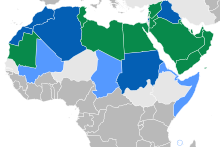Semitic language and lingua franca of the Arab world From Wikipedia, the free encyclopedia
Arabic (العربية, al-ʿarabiyyah) is a Semitic language that first appeared in the mid-ninth century BCE in Northern Arabia and Sahara southern Levant. It is related to other Semitic languages like Hebrew and Aramaic.[14][15] Unlike the latter two, where the former derives from the other, however, Arabic is itself a root language, like Latin. Unlike Latin, it is still widely used and spoken today. Around 292 million people speak it as their first language. Many more people can also understand it as a second language in the Maghreb. The Arabic language is written from right to left in a consonant alphabet, which is also called an abjad.[16] Since it is so widely spoken throughout the world, the language is one of the six official languages of the United Nations. The other official languages of the UN are: English, French, Spanish, Russian and Chinese.[17]
| Arabic | |
|---|---|
| اَلْعَرَبِيَّةُ al-ʿarabiyyah | |
 al-ʿarabiyyah in written Arabic (Naskh script) | |
| Pronunciation | [ˈʕarabiː] ( [al ʕaraˈbijːa] ( |
| Native to | Egypt United Arab Emirates Saudi Arabia Cyprus Morocco Western Sahara Senegal Israel Mali Niger Philippines Palestine Algeria Zanzibar Chad Mauritania Tunisia Libya Sudan South Sudan Qatar Kuwait Bahrain Iraq Lebanon Syria Somalia Eritrea Djibouti Malta Comoros Iran Pakistan Malaysia Turkey Indonesia |
| Ethnicity | Arabs and several other peoples of the Middle East and North Africa |
| Speakers | 380 million native speakers of all varieties (2024)[1] 330 million L2 users of Modern Standard Arabic (2023)[2] |
Early forms | Proto-Afroasiatic
|
Standard forms | |
| Dialects |
|
| Arabic alphabet
Others
| |
| Signed Arabic (different national forms) | |
| Official status | |
Official language in | 27 states and territories
International Organizations Special status in Constitution |
Recognised minority language in | |
| Regulated by | List
|
| Language codes | |
| ISO 639-1 | ar |
| ISO 639-2 | ara |
| ISO 639-3 | ara – inclusive codeIndividual codes: arq – Algerian Arabicxaa – Andalusi Arabicabv – Bahrani Arabicavl – Bedawi Arabicshu – Chadian Arabicacy – Cypriot Arabicadf – Dhofari Arabicarz – Egyptian Arabicacm – Gelet Iraqi Arabicafb – Gulf Arabicayh – Hadhrami Arabicmey – Hassaniya Arabicacw – Hejazi Arabicapc – Levantine Arabicayl – Libyan Arabicary – Moroccan Arabicars – Najdi Arabicacx – Omani Arabicayp – Qeltu Iraqi Arabicaao – Saharan Arabicaec – Saʽidi Arabicayn – Sanʽani Arabicssh – Shihhi Arabicsqr – Siculo-Arabicarb – Standard Arabicapd – Sudanese Arabicacq – Taʽizzi-Adeni Arabicabh – Tajiki Arabicaeb – Tunisian Arabicauz – Uzbeki Arabic |
| Glottolog | arab1395 |
| Linguasphere | 12-AAC |
 Sole official language, Arabic-speaking majority
Sole official language, Arabic-speaking minority
Co-official language, Arabic-speaking majority
Co-official language, Arabic-speaking minority | |
Many countries speak Arabic as an official language, but not all of them speak it the same way. The language has many dialects, or varieties, such as Modern Standard Arabic, Egyptian Arabic, Gulf Arabic, Maghrebi Arabic , Levantine Arabic and many others. Some of the dialects are spoken so differently from one another that some speakers have a hard time understanding the other. Many dialectic words however are nonetheless still rooted in the original, or classical language.
Most of the countries that use Arabic as their official language are in the Middle East. They are part of the Arab world, the largest religion in the region is Islam. The Arabic language is considered to be the language of Islam as the Quran was revealed in the Arabic language and it was also the native language of and spoken by Muhammad, the religion's prophet.
Arabic is very important in Islam because Muslims believe that Allah (God) used it to talk to Muhammad through the Archangel Gabriel (Jibril), giving him the Quran in the language. Many but not all Arabic-speakers are Muslims. The miracle of the Quran is believed to be in its language.
Arabic is also becoming a popular language to learn in the Western world even though its grammar is sometimes very hard to learn for native speakers of Indo-European languages. Many other languages have borrowed words from Arabic because of its importance in history. Some English words that can be traced to Arabic are sugar,[18] cotton,[19] magazine,[20] algebra,[21] alcohol[22] and emir.[23][24][25]
Arabic is an official language of these countries:
It is also a national language of:
The Arabic alphabet is a consonant alphabet with 31 letters, as listed below:
Seamless Wikipedia browsing. On steroids.
Every time you click a link to Wikipedia, Wiktionary or Wikiquote in your browser's search results, it will show the modern Wikiwand interface.
Wikiwand extension is a five stars, simple, with minimum permission required to keep your browsing private, safe and transparent.